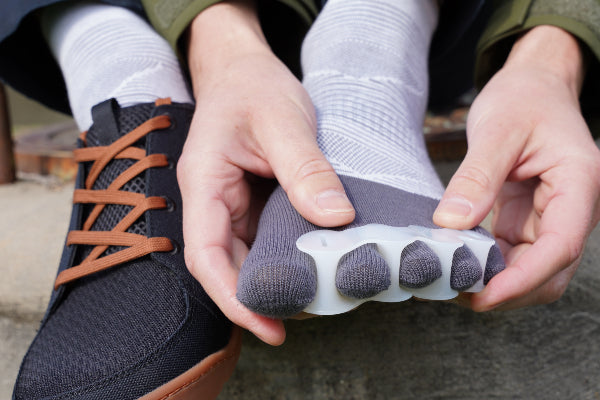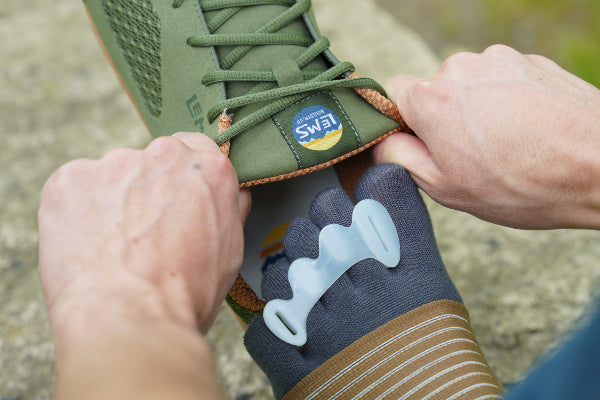Toe Extensor Stretch

The Toe Extensor Stretch—a simple stretch of the toe extensor muscles and tendons—is perhaps the single most important stretch or exercise for foot health. Most conventional shoes... Read more
In this informative video, Dr. Ray McClanahan—a sports podiatrist at Northwest Foot and Ankle and the inventor of Correct Toes—discusses (and demonstrates!) a helpful manual technique for stretching and releasing the soft tissues associated with a bunion deformity. This technique can be used by healthcare providers for their patients, or it can be used by patients as a self-care technique at home.
Here’s a quote from Dr. Ray that debunks a common bunion-related myth:
Bunions are NOT a growth of bone that forms on the side of the toe. They ARE a dislocation of the big toe joint. Misinformation by medical providers and internet sites is a primary reason why patients are talked into having an operation to remove what they erroneously believe is a growth of bone.
Watch this video to learn more about bunions and how to perform the Big Toe Stretch. And check out this blog post to learn how to use a helpful tool, BlackBoard ToeBands, to perform a similar stretch to help restore the big toe to its intended position in line with its corresponding metatarsal bone.
Disclaimer:
The above content is for educational or informational purposes only and is not intended to replace or augment professional medical instruction, diagnosis, or treatment. Read full disclaimer here.$65.00
$10.00
$14.00
$70.00
$30.00
$30.00

The Toe Extensor Stretch—a simple stretch of the toe extensor muscles and tendons—is perhaps the single most important stretch or exercise for foot health. Most conventional shoes... Read more

In this video, Dr. Ray McClanahan, a sports podiatrist at Northwest Foot and Ankle and the inventor of Correct Toes, demonstrates a two-part stretch that can be... Read more


I started to wear Aravon shoes with Powerstep Pinnacle inserts due to my chiro telling me to get better shoes because of a bunion. At the store, the salesman stated I needed one size larger because most people wear their shoes too small. After wearing these almost exclusively for about three weeks, my bunion seems to ache more than it did before I started wearing these shoes! Also whenever I take them off, my smallest toe and the one next to it gets numb on the “pads,” not the whole toe. Is that normal after switching to larger and roomier toe box shoes? Don’t want to have to go to a podiatrist. Thanks!
Greetings, Char,
Thank you for your comment. And thank you for your question. I’m not sure what specific model of shoe you’ve been wearing, but if the toe box doesn’t allow for natural toe splay, it’s not likely to help your bunion discomfort. As for the numbness you’ve been experiencing, my recommendation is to contact a naturally-minded foot care professional in your area to get a better sense of what’s happening in your specific case. You can find a list of such practitioners here:
www.nwfootankle.com/resources/122-healthcare-providers
Hopefully there is someone in your area who can give you more insight into what’s going on.
Kind regards,
Marty Hughes, DC
Hello! Thank you so much for all of the information you have available on your website—it has been invaluable. I have had sore feet for quite a few years now. I bought Correct Toes a couple of years ago but have never been really disciplined about wearing them. Could you tell me how long I should be wearing them every day so that I can really help myself? Also, I was wondering if you know of any practitioners in Australia, specifically Melbourne, that I could visit to get some help? Thank you very much.
Hi, Jacqui,
Thank you for your message. And thank you for your kind words about the site! We’re happy to know that you’ve benefitted from it.
In terms of daily Correct Toes use, we usually recommend a gradual approach, wearing them for short periods of time at first (say, 30 minutes per day) and then slowly increasing wear-time as your feet and toes begin to adapt to the spacers. Many people find that, ultimately, they can wear Correct Toes for most or all of the day.
Unfortunately, at this time, we don’t know of any natural foot care providers in Melbourne.
If you have any further questions, please just let us know.
Kind regards,
Marty Hughes, DC
Hello! Can you tell me which foot cream is being used in this video?
Hi, Heike,
Great question! The deep heat cream used in this video is made by a company called Sombra.
I hope this info helps!
Kind regards,
Marty Hughes, DC
Can capsulitis of the 2nd toe be corrected (non-surgically)?
Hi, Dorothy,
Thank you for your question. In most cases, yes, capsulitis of the 2nd toe can be corrected nonsurgically. I recommend that you check out this video to learn more about conventional vs. natural approaches to capsulitis:
www.naturalfootgear.com/blogs/educational-articles/ball-of-foot-pain-conventional-vs-natural-approaches
Please let us know if you have any other questions we can assist with!
All the best,
Robyn Hughes, ND
Hello, Dr. Marty. I was so glad to discover your website. I am recovering from bunion surgery this past November as well as a bony fusion. Now I am keen to get back to full function, which hopefully includes yoga and hiking—fingers crossed. I have lots of questions, but I guess my main ones are: 1) Is barefoot walking the optimal state, or do feet need more support?; 2) Are sandals also fine to wear a lot of the time, or, again, are shoes more supportive and/or necessary? Any other tips to help with my recovery would be much appreciated. Correct Toes are on my budget for next month. Thanks from New Zealand!
Greetings, Sharon from New Zealand! Thank you for posting your comment, and thank you for your questions. Some thoughts for you:
From our perspective, barefoot walking is indeed the optimal state, though in our societies, it’s not always possible to achieve this, given societal expectations surrounding foot coverings and the fact that most sets of feet require fairly extensive rehabilitation in order to achieve comfortable barefoot walking. So, the next best thing is to don footwear that lets your foot function like a barefoot inside the shoe. Ideally, then, footwear should serve only as a basic protective covering and let the foot do most of the weight-bearing and propulsive work.
In terms of sandals, we sure do love wearing them as much as possible! A good sandal possesses all of the same characteristics as a good closed-toe shoe (with the added benefit of a healthier environment for the foot): A zero drop platform for natural arch support, a wide footbed to allow for optimal toe splay, and a flexible sole to build foot strength and resiliency. I will say, when it comes to sandals, we prefer models that incorporate a heel strap, which helps to prevent repetitive toe flexion or grabbing (like what sometimes happens with ill-fitting flip-flops). So, a good sandal should indeed provide all the “support” your foot requires and is a fine option in warmer climates and conditions.
I hope this info helps! Please let us know if you have any further questions for us!
Kind regards,
Marty Hughes, DC